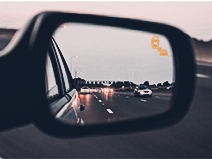Auto Driving Safety And Blind Spot Mirrors. - Vol.458
 !
!
Whenever you drive, you need to change lanes or merge into traffic. Those are the most routine maneuvers for every driver! However, they can also be the most dangerous ones - because of the blind spots.
The blind spot is that area around your vehicle that you cannot directly observe while at the driver's seat. Not visible with your peripheral vision, neither in the inside and side mirrors... it's called the blind spot because you're literally blind to its existence.
Needless to say, having a blind area around your vehicle can easily lead to an accident! There could be another vehicle right on your side, but you're not able to see it: everything looks clear, you're prepared to switch lanes, and then...
The sad truth is, having blind areas around your vehicle is inevitable while driving. A driver can try to adjust his rear view center mirror, and the side view mirrors, in a way such as to minimize the occurrence of the blind zones. It's interesting to note that, for generations, drivers have been setting their side view mirrors incorrectly; there's no need to adjust the side view mirror so you can see the back corner of your car: it never moves - so why keep an eye on it?
You can indeed somewhat reduce your blind zone by carefully setting the mirrors so that the side of your car is barely visible. Using a method of adjusting the side mirrors devised by George Platzer, it is possible to eliminate the blind area on the side of a vehicle. That can greatly reduce the probability of side swipes and similar accidents that frequently occur when changing lanes.
However, your remaining blind area is still large enough to be completely capable of hiding an entire vehicle!
You can see a car coming up behind you in your mirror, you can see it next to your car through your window as he passes... but for a few seconds between those two, it was invisible!
Some cars have bigger blind areas than others, but they all have them.
Larger vehicles, such as increasingly popular SUVs, pickups and minivans, have larger blind zones than a passenger car. It also looks like the A-pillars in the newest cars, which are designed to be steeper in order to improve security, could lead to huge blind zones, potentially obscuring cars and people.
As a matter of fact, the blind area around an average automobile is about the size of a large swimming pool. Another chilling fact is that in the time it takes you to turn your head in order to check your blind area, your vehicle has already traveled more than half of a football field! And it only gets worse with today's drivers whose attention is always dissipated: checking the blind areas is one of the first activities to suffer when the driver is distracted. Did you know that the area immediately behind your vehicle has been nicknamed a "killing zone"? It's a source of back-up collisions, particularly involving pedestrians and objects directly aft of a vehicle. There is no method of adjusting your mirrors that can help with rearward visibility.
To help to deal with this situation Picknbuy offers a large range of vehicles now equipped with parking sensors, sonars, or backup cameras that can help you identify objects behind you not visible in the rear view mirror. However, don't rely on those gadgets only, but remember to always take a look behind your vehicle yourself.
When you're in another driver's blind zone, he just can't see you. You can't be certain that the other driver will check over his shoulders when he needs to change lanes either. The rule of thumb is that if you can't see a driver in his rear view mirror - he can't see you at all! If you think you may be in another driver's blind spot, try not to linger in that area.
Another option is buying a blind spot mirror! Blind spot mirrors are just that: the mirrors that allow you to see your blind spot.
There are several types of blind spot mirrors: which one you'll choose depends on your personal preferences. The blind spot mirror that goes on top of your side view mirror is typically a large, oval mirror. There is a smaller, circular blind spot mirror that sticks on the physical surface of your side view mirror.
Having a blind spot mirror is not a substitute for looking over your shoulders, but a welcome addition to your driving safety. Of course, for the blind spot mirror to work as intended, you should take some time to properly adjust it, and become accustomed to actually using it. It goes without saying that you should always use your vehicle turn signal and perform a shoulder check in advance of changing lanes!
Article Source: https://EzineArticles.com/expert/Anita_Bern/232243